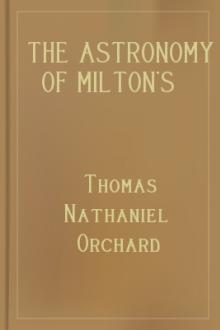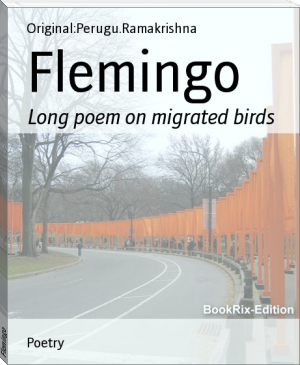The Astronomy of Milton's 'Paradise Lost' by Thomas Nathaniel Orchard (easy books to read in english TXT) 📕

- Author: Thomas Nathaniel Orchard
- Performer: -
Book online «The Astronomy of Milton's 'Paradise Lost' by Thomas Nathaniel Orchard (easy books to read in english TXT) 📕». Author Thomas Nathaniel Orchard
The selection of astronomy as one of the subjects in which Milton instructed his pupils affords us evidence that he must have devoted considerable time and attention to acquiring a knowledge of the facts and details associated with the study of the science. In the attainment of this he had to depend upon his own exertions and the assistance derived from astronomical books; for at this time astronomy received no recognition as a branch of study at any of the universities; and in Britain the science attracted less attention than on the Continent, where the genius of Kepler and Galileo elevated it to a position of national importance.
We shall find as we proceed that Milton’s knowledge of astronomy was comprehensive and accurate; that he was familiar with the astronomical reasons by which many natural phenomena which occur around us can be explained; and that he understood many of the details of the science which are unknown to ordinary observers of the heavens.
It is remarkable how largely astronomy enters into the composition of ‘Paradise Lost,’ and we doubt if any author could have written such a poem without possessing a knowledge of the heavens and of the celestial orbs such as can only be attained by a proficient and intimate acquaintance with this science.
The arguments in favour of or against the Ptolemaic and Copernican theories were well known to Milton, even as regards their minute details; and in Book viii. he introduces a scientific discussion based upon the respective merits of those theories. The configuration of the celestial and terrestrial spheres, and the great circles by which they are circumscribed, he also knew. The causes which bring about the change of the seasons; the obliquity of the ecliptic; the zodiacal constellations through which the Sun travels, and the periods of the year in which he occupies them, are embraced in Milton’s knowledge of the science of astronomy. The motions of the Earth, including the Precession of the Equinoxes; the number and distinctive appearances of the planets, their direct and retrograde courses, and their satellites, are also described by him. The constellations, and their relative positions on the celestial sphere; the principal stars, star-groups, and clusters, and the Galaxy, testify to Milton’s knowledge of astronomy, and to the use which he has made of the science in the elaboration of his poem.
The names of fourteen of the constellations are mentioned in ‘Paradise Lost.’ These, when arranged alphabetically, read as follows:—
Andromeda, Aries, Astrea, Centaurus, Cancer, Capricornus, Gemini, Leo, Libra, Ophiuchus, Orion, Scorpio, Taurus, and Virgo. Milton’s allusions to the zodiacal constellations are chiefly associated with his description of the Sun’s path in the heavens; but with the celestial sign Libra (the Scales) he has introduced a lofty and poetical conception of the means by which the Creator made known His will when there arose a contention between Gabriel and Satan on his discovery in Paradise.
Hung forth in Heaven his golden scales, yet seen
Betwixt Astrea[6] and the Scorpion sign,
Wherein all things created first he weighed,
The pendulous round Earth with balanced air
In counterpoise, now ponders all events,
Battles and realms. In these he put two weights,
The sequel each of parting and of fight:
The latter quick up flew, and kicked the beam.—iv. 996-1004.
Orion, the finest constellation in the heavens, did not escape Milton’s observation, and there is one allusion to it in his poem. It arrives on the meridian in winter, where it is conspicuous as a brilliant assemblage of stars, and represents an armed giant, or hunter, holding a massive club in his right hand, and having a shield of lion’s hide on his left arm. A triple-gemmed belt encircles his waist, from which is suspended a glittering sword, tipped with a bright star. The two brilliants Betelgeux and Bellatrix form the giant’s shoulders, and the bright star Rigel marks the position of his advanced foot. The rising of Orion was believed to be accompanied by stormy and tempestuous weather. Milton alludes to this in the following lines:—
Hath vexed the Red Sea coast, whose waves o’erthrew
Busiris and his Memphian chivalry.—i. 305-7.
Andromeda is described as being borne by Aries, and in ‘Ophiuchus huge’ Milton locates a comet which extends the whole length of the constellation. It is evident that Milton possessed a precise knowledge of the configuration and size of the constellations, and of the positions which they occupy relatively to each other on the celestial sphere.
Though Milton was conversant with the Copernican theory, and entertained a conviction of its accuracy and truthfulness, and doubtless recognised the superiority of this system, which, besides conveying to the mind a nobler conception of the universe and of the solar system—though it diminished the importance of the Earth as a member of it—was capable of explaining the occurrence of celestial phenomena in a manner more satisfactory than could be arrived at by the Ptolemaic theory. Notwithstanding this, he selected the Ptolemaic cosmology as the scientific basis upon which he constructed his ‘Paradise Lost,’ and in its elaboration adhered with marked fidelity to this system. There were many reasons why Milton, in the composition of an imaginative poem, should have chosen the Ptolemaic system of the universe rather than the Copernican. This form of astronomical belief was adopted by all the authors whose works he perused and studied in his younger days, including his favourite poet, Dante; and his own poetic imaginings, as indicated by his early poems, were in harmony with the doctrines of this astronomical creed, a long acquaintance with which had, without doubt, influenced his mind in its favour. This system of revolving spheres, with the steadfast Earth at its centre, and the whole enclosed by the Primum Mobile, constituted a more attractive and picturesque object for poetic description than the simple and uncircumscribed arrangement of the universe expressed by the Copernican theory. It also afforded him an opportunity of localising those regions of space in which the chief incidents in his poem are described—viz. Heaven, or the Empyrean, Chaos, Hell, and the Mundane Universe. Milton’s Ptolemaism, with its adjuncts, may be understood by the following:
All that portion of space above the newly created universe, and beyond the Primum Mobile, was known as Heaven, or The Empyrean—a region of light, of glory, and of happiness; the dwelling-place of the Deity, Who, though omnipresent, here visibly revealed Himself to all the multitude of angels whom He created, and who surrounded his throne in adoration and worship.
Underneath the universe there existed a vast region of similar dimensions to the Empyrean, called Chaos, which was occupied by the embryo elements of matter, that with incessant turmoil and confusion warred with each other for supremacy—a wild abyss—
The lower portion of this region was divided off from the remainder, and embraced the locality known as Hell—the place of torment, where the rebellious angels were driven and shut in after their expulsion from Heaven.
As from the centre thrice to the utmost pole.—i. 73-74.
The New Universe, which included the Earth and all the orbs of the firmament known as the Starry Heavens, was created out of Chaos, and hung, as if suspended by a golden chain, from the Empyrean above; and although its magnitude and dimensions were inconceivable, yet, according to the Ptolemaic theory, it was enclosed by the tenth sphere or Primum Mobile.
By this partitioning of space Milton was able to contrive a system which fulfilled the requirements of his great poem.
The annexed diagram explains the relative positions of the different regions into which space was divided.
Though there are traces of Copernicanism found in ‘Paradise Lost,’ yet Milton has very faithfully adhered to the Ptolemaic mechanism and nomenclature throughout his poem.
In his description of the Creation, the Earth is formed first, then the Sun, followed by the Moon, and afterwards the stars, all of which are described as being in motion round the Earth. Allusion is also made to this ancient system in several prominent passages, and in the following lines there is a distinct reference to the various revolving spheres.
And that crystalline sphere whose balance weighs
The trepidation talked, and that first moved.—iii. 481-83.
The seven planetary spheres are first mentioned; then the eighth sphere, or that of the fixed stars; then the ninth, or crystalline, which was believed to cause a shaking, or trepidation, to account for certain irregularities in the motions of the stars; and, lastly, the tenth sphere, or Primum Mobile, called the ‘first moved’ because it set the other spheres in motion.
To an uninstructed observer, the apparent motion of the heavenly bodies round the Earth would naturally lead him to conclude that, of the two theories, the Ptolemaic was the correct one. We therefore find that Milton adopted the system most in accord with the knowledge and intelligence possessed by the persons portrayed by him in his poem; and in describing the natural phenomena witnessed in the heavens by our first parents, he adheres to the doctrines of the Ptolemaic system, as being most in harmony with the simple and primitive conceptions of those created beings.
To their upward gaze, the orbs of heaven appeared to be in ceaseless motion; the solid Earth, upon which they stood, was alone immovable and at rest. Day after day they observed the Sun pursue his steadfast course with unerring regularity: his rising in the east, accompanied by the rosy hues of morn; his meridian splendour, and his sinking in the west, tinting in colours of purple and gold inimitable the fleecy clouds floating in the azure sky, as he bids farewell for a time to scenes of life and happiness, rejoicing in the light and warmth of his all-cheering beams. With the advent of night they beheld the Moon, now increasing, now waning, pursue her irregular path, also to disappear in the west; whilst, like the bands of an army marshalled in loose array, the constellations of glittering stars, with stately motion, traversed their nocturnal arcs, circling the pole of the heavens.
By referring to Book viii., 15-175, we find an account of an interesting scientific discussion, or conversation, between Adam and Raphael regarding the merits of the Ptolemaic and Copernican systems, and of the relative importance and size of the heavenly bodies. By it we are afforded an opportunity of learning how accurate and precise a knowledge Milton possessed of both theories, and in what clear and perspicuous language he expresses his arguments in favour of or against the doctrines associated with each.
We may, with good reason, regard the views expressed by Adam as representing Milton’s own opinions, which were in conformity with the Copernican theory; and in the Angel’s reply, though of an undecided character, we are able to perceive how aptly Milton describes the erroneous conclusions upon which the Ptolemaic theory was based.
In this scientific discussion, it would seem rather strange that Adam, the first of men, should have been capable of such philosophic reasoning, propounding, as if





Comments (0)